
Monmouth is a market town and community in Monmouthshire, Wales, situated on where the River Monnow joins the River Wye, two miles from the Wales–England border. The population in the 2011 census was 10,508, rising from 8,877 in 2001. Monmouth was the county town of historic Monmouthshire, although Abergavenny is the largest settlement and Monmouthshire County Council has its main offices at Rhadyr, just outside Usk. Monmouth is in the UK Parliament constituency of Monmouthshire and the Senedd constituency of Monmouth.

Newport is a city and county borough in Wales, situated on the River Usk close to its confluence with the Severn Estuary, 12 mi (19 km) northeast of Cardiff. The population grew considerably between the 2011 and the 2021 census, rising from 145,700 to 159,587, the largest growth of any unitary authority in Wales. Newport is the third-largest principal authority with city status in Wales, and sixth most populous overall. Newport became a unitary authority in 1996 and forms part of the Cardiff-Newport metropolitan area, and the Cardiff Capital Region.

Monmouthshire is a county in the south east of Wales. It borders Powys to the north; the English counties of Herefordshire and Gloucestershire to the north and east; the Severn Estuary to the south, and Torfaen, Newport and Blaenau Gwent to the west. The largest town is Abergavenny, and the administrative centre is Usk.

Until 1974, Monmouthshire, also formerly known as the County of Monmouth, was an administrative county in the south-east of Wales, on the border with England, and later classed as one of the thirteen historic counties of Wales. Its area now corresponds approximately to the present principal areas of Monmouthshire, Blaenau Gwent, Newport and Torfaen, and those parts of Caerphilly and Cardiff east of the Rhymney River.

Lliswerry, or Liswerry is an electoral district (ward) and community of the city of Newport, South Wales. The area is governed by Newport City Council. It is the largest community/ward in the city.
St Julians is a community and coterminous electoral district (ward) of the City of Newport, South Wales.
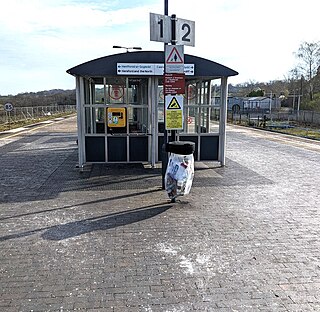
Pontypool and New Inn railway station is situated to the south east of Pontypool town centre between the town and the suburb of New Inn, Wales. The station was formerly called Pontypool Road until renamed just Pontypool in 1972 and then to the present name in 1994.

HM Prison Usk is a Category C men's prison, located in Maryport Street in Usk, Monmouthshire, Wales. The prison is operated by His Majesty's Prison Service, and jointly managed with the nearby HMP Prescoed.

Coleg Gwent is Wales' largest further education college at various locations in the former county of Gwent, South Wales.
Maesglas or Maes-glas is a neighbourhood in the south west of the city of Newport, South Wales. In the 16th century it was recorded as Greenfield but the Welsh language name Maesglas has remained the more widely used, among English speakers.

Newport city centre is traditionally regarded as the area of Newport, Wales bounded by the west bank of the River Usk, the George Street Bridge, the eastern flank of Stow Hill and the South Wales Main Line. Most of the city centre is contained within two conservation areas: the central area and the area around Lower Dock Street. Most of the city centre is located in the Stow Hill district.

The Sessions House at Usk, Wales, is a Victorian courthouse by Thomas Henry Wyatt of 1877. It is a Grade II* listed building as of 4 January 1974.
This is a list of Sheriffs of Monmouthshire, an office which was created in 1536 but not fully settled until 1540.
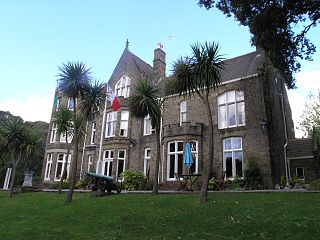
The Mansion House is a historic building in Ffynone Road in Swansea, Wales. The building was commissioned as a private residence but, since 1922, it has accommodated the official residence of the Lord Mayor of Swansea.

The Shire Hall, Monmouth, Wales, is a prominent building on Agincourt Square in the town centre. It was built in 1724, and was formerly the centre for the Assize Courts and Quarter Sessions for Monmouthshire. The building was also used as a market place. In 1839–40, the court was the location of the trial of the Chartist leader John Frost and others for high treason for their part in the Newport Rising.
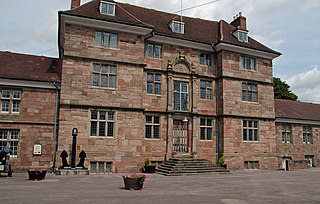
Great Castle House is a former town house built on the site of part of Monmouth Castle in Wales. Amongst the town's most significant buildings, it has a Grade I listing and is one of 24 sites on the Monmouth Heritage Trail. The house is located on Castle Hill, off Agincourt Square in Monmouth town centre.
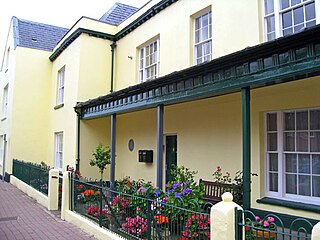
The Judges' Lodgings, located in Whitecross Street, Monmouth, south east Wales, is an eighteenth-century building, with earlier origins, on the edge of St James' Square. It has its origins as an early 16th-century town house, becoming the 'Labour in Vain' inn around 1756. It was in use as the Judges' Lodgings for the Monmouth Assizes before 1835, and as the Militia Officers' Mess in the 1870s. Today it is a private house, with modern mews cottages built into the rear. It is a Grade II listed building and is one of 24 blue plaque buildings on the Monmouth Heritage Trail.
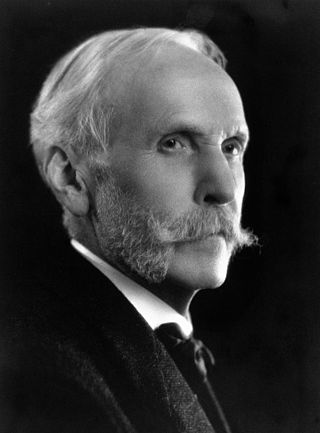
Sir Abraham Garrod Thomas was a Welsh physician, philanthropist, magistrate, politician and Member of Parliament.
Stelvio House on Bassaleg Road, Newport, Wales was the home of Charles Henry Bailey, a 19th century industrialist. Bailey, an engineer by training, owned the Tyne Engine Works at Newport and also published a number of almanacs mainly related to shipping matters; including C. H. Bailey's Book of translations: 5,200 marine technical terms in English, German, French, Italian, Spanish & Norwegian, C. H. Bailey's Tables of Distances from Port to Port and C. H. Bailey's Book of Useful Information.

Glen Usk, Llanhennock, Monmouthshire is a country house dating from 1820. It was built for Sir Digby Mackworth, Bt. in the Neoclassical style. The house is Grade II* listed and the adjoining temple, and other associated structures, have their own Grade II listings. The gardens are included on the Cadw/ICOMOS Register of Parks and Gardens of Special Historic Interest in Wales.

















